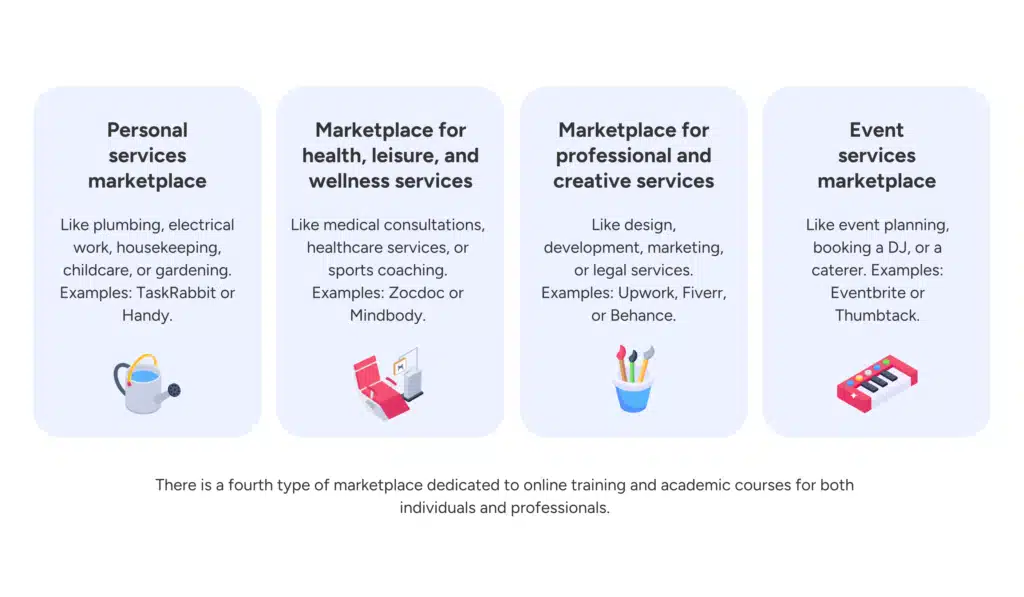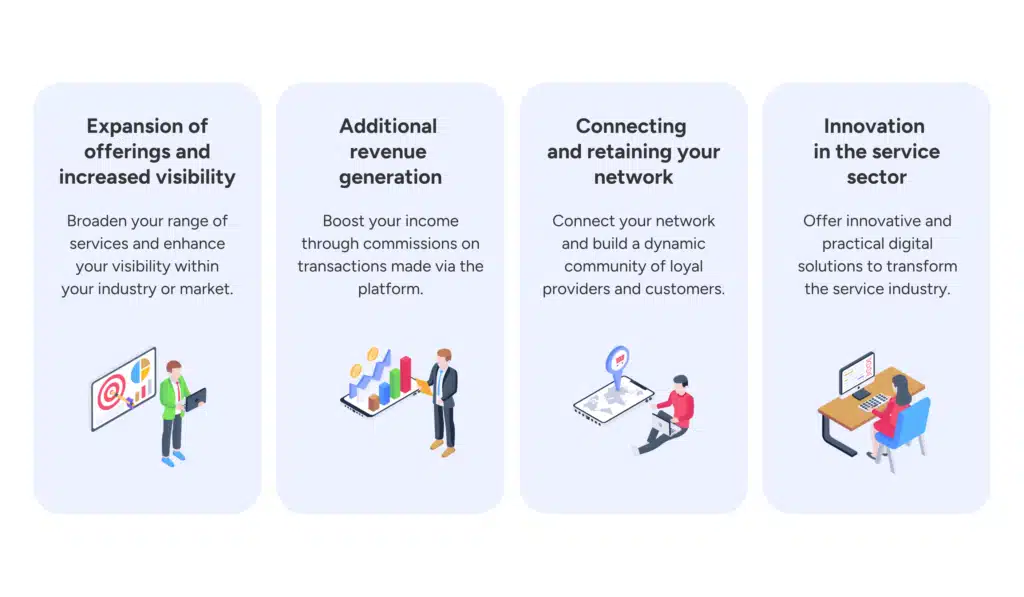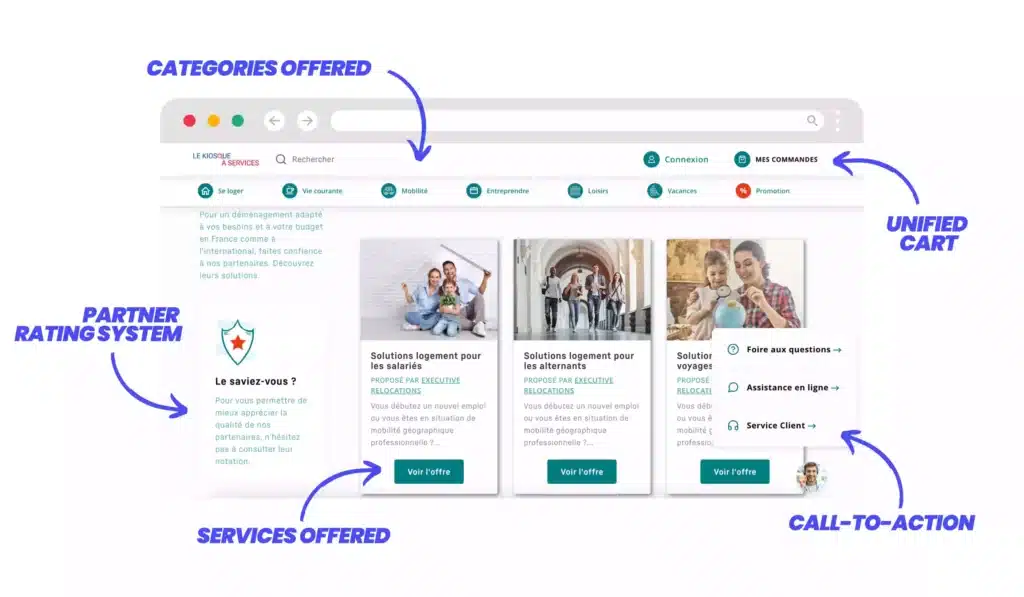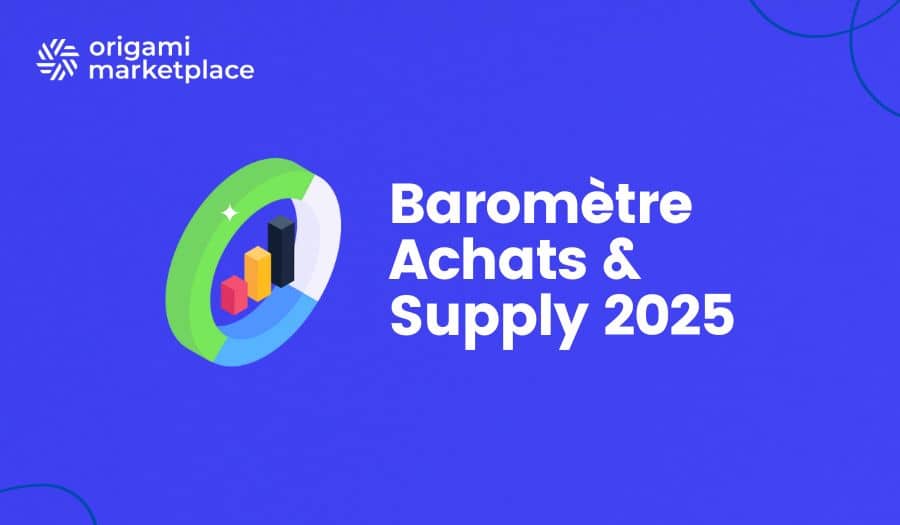How to create a Service Marketplace? Practical Guide
- Arnaud
- 6-minute read

Have you ever considered creating your own service marketplace? With the rise of digital technology, these platforms are becoming increasingly essential. They offer a unique opportunity to connect service providers directly with consumers, creating a mutually beneficial ecosystem for everyone involved. Whether you’re an entrepreneur looking for a new venture, a retailer aiming to expand your offerings, or a business seeking growth avenues that align with current trends, this guide is for you.
We’ll guide you step-by-step in building your service marketplace, providing you with practical advice and proven strategies. Ready to dive into this exciting journey?
Key points for successfully designing a service marketplace:
1. The Marketplace Model
a. Marketplace vs. E-commerce
b. Service marketplace vs. product marketplace
2. Types and roles of marketplaces
a. Different types of marketplaces
b. Different types of service marketplaces
c. The role of a service marketplace
3. Service marketplace: a growth opportunity
4. Strategy and design of a service marketplace
a. Defining the business model
b. Market research and business plan
c. Optimizing the payment process
d. Selecting vendors
e. Offering optimized SEO
f. Establishing a communication plan
g. Ensuring legal compliance
h. Defining relevant KPIs
i. Management methods
5. Three key points for designing your service marketplace
a. Solving the chicken-and-egg problem
b. Making your service marketplace user-friendly
c. Ensuring safety and reliability
6. Designing a service marketplace with SaaS solutions
7. Steps to create a service marketplace
8. Tools for creating a service marketplace
9. Examples of successful service marketplaces
1. The marketplace model
a. Marketplace vs. E-commerce
You might be wondering about the difference between a marketplace and a traditional e-commerce site. Simply put, an e-commerce site sells its own products or services, while a marketplace allows third parties to sell on its platform.
While both marketplaces and e-commerce platforms enable online purchases, their primary distinction lies in how sales occur. E-commerce offers direct sales from a specific vendor, while a marketplace functions more like a physical market, hosting multiple vendors on a single platform.
In essence, digital marketplaces are virtual marketplaces. Just like a physical market, they bring multiple sellers together on a remote sales platform. Think of Amazon or Rakuten: they sell products directly but also allow thousands of other sellers to use their platforms. These are genuine online marketplaces where various vendors can offer their products or services.
b. Service marketplace vs. product marketplace
There is a significant distinction between product marketplaces (like Amazon) and service marketplaces (like Airbnb or Uber). The goal of a product marketplace is to sell products online (Amazon, Alibaba, Etsy, etc.), while a service marketplace facilitates the sale of services (UberEats, Airbnb, Malt, Service Kiosk, etc.). Service marketplaces focus on connecting clients with service providers, delivering a user experience tailored to specific client needs in real time.
Initially, product marketplaces emerged, serving as intermediaries between producers and clients, offering an alternative to e-commerce that was not always accessible to all, particularly small merchants. With the growth of online sales, service providers have also adopted this model to unlock further growth potential for their businesses.
Today, thanks to various marketplaces, consumers can purchase or book products and services online.
2. Types and roles of marketplaces
a. Different types of marketplaces
There are several types of marketplaces: B2B (business-to-business), B2C (business-to-consumer), and C2C (consumer-to-consumer). Each has unique characteristics and benefits. For instance, a B2B marketplace may connect businesses for specialized services, whereas a B2C platform directly targets end consumers.
b. Different types
In service marketplaces, models can include professional services (such as consultants), personal services (like life coaches), or shared services (like vacation rentals). It’s crucial to clearly define your niche and tailor your offering accordingly.
c. The role
The primary role is to facilitate connections between service providers and customers. It must offer an intuitive user interface, effective communication tools, and a secure payment system. These elements build trust and encourage transactions on the platform.
Different service and connection types:

3. Service marketplace: a growth opportunity
Creating a service marketplace can represent a tremendous growth opportunity. With the ever-expanding global market for online services, businesses that capitalize on this trend can gain a competitive edge. Moreover, the flexibility offered by a marketplace allows quick adaptation to market changes and customer needs.
Service marketplaces cater to various actors and address real consumer needs. For instance, small merchants or artisans who are not visible online can leverage a service marketplace. We know that most service-related searches are now conducted online. Who doesn’t first type “trusted plumber in Dublin” or “recommended kitchen designer in London” to find a service? Booking a medical consultation or yoga class online has become second nature.

4. Strategy and design of a service marketplace
a. Defining your marketplace’s business model
Whether or not you have experience creating businesses, it is essential to define a clear business model for your service marketplace. Will you take a commission on each transaction? Offer subscriptions to providers? Or perhaps a freemium model?
b. Conducting market research and creating a business plan
Thorough market research will help you understand your potential clients’ needs and the existing competition. A solid business plan will guide you throughout the creation process and attract investors.
c. Optimizing the payment process
A smooth and secure payment process is critical for earning user trust. Integrate reliable payment solutions and ensure they comply with applicable regulations.
d. Selecting vendors
The quality of your marketplace will largely depend on the service providers you recruit. Set strict selection criteria and verify the providers’ qualifications and customer reviews.
e. Offering optimized SEO
Good SEO is crucial for attracting traffic to your marketplace. Use relevant keywords, optimize service descriptions, and ensure your site is fast and mobile-friendly.
f. Establishing a communication plan
A well-crafted communication plan will help promote your marketplace and attract users. Use a mix of digital marketing, social media, and public relations to maximize visibility.
g. Ensuring legal compliance
Make sure your marketplace complies with all local and international regulations, including data protection, transaction management, and tax obligations.
h. Defining relevant KPIs
To measure your marketplace’s success, define relevant KPIs (key performance indicators). These may include the number of active users, transaction volume, or customer satisfaction.
i. Management methods
Adopt efficient management methods to maintain your marketplace’s quality. This includes managing provider relationships, customer support, and technical platform maintenance.
Download our free requirement specification template
Access essential functionalities to successfully build your C2C, B2C, or B2B marketplace. This simple-to-use backlog template will support you at every project stage.
5. Three key points for designing your service marketplace
a. Solving the chicken-and-egg problem
The classic challenge of any marketplace is solving the chicken-and-egg dilemma: attracting enough providers to draw clients and vice versa. Start with a small niche and gradually expand your offerings.
b. Making your service marketplace user-friendly
User-friendliness is crucial for attracting and retaining users. Ensure your platform is easy to use, with intuitive navigation and features tailored to user needs.
c. Ensuring safety and reliability
Security and reliability are top priorities. Implement robust security protocols, regularly verify providers, and offer responsive customer support.
6. Designing a service marketplace with SaaS solutions
Opting for a specialized SaaS solution provider like Origami Marketplace can save time and prevent costly mistakes. An expert team can help design a custom platform, develop an effective marketing strategy, and ensure legal compliance.
7. Steps to create a service marketplace
Key steps for creating a service marketplace include:
- Defining your concept and business model
- Conducting market research and developing a business plan
- Designing and developing the platform
- Recruiting service providers
- Launching marketing campaigns to attract users
- Monitoring performance and adjusting your strategy accordingly
The team's advice 🎓
Don’t underestimate the importance of user experience! For a service marketplace to thrive, focus on providing a smooth and intuitive user interface. Regularly test your platform with real users to identify and resolve friction points. By offering a seamless experience, you not only increase customer satisfaction but also build loyalty and encourage user recommendations. Stay attentive to feedback and continuously adapt your site to meet users’ needs and expectations.
8. Tools for creating a service marketplace
Numerous tools and providers are available for creating a service marketplace, ranging from turnkey platforms to custom solutions developed by specialized agencies. It’s essential to choose the tool that best suits your needs and budget.
Not all marketplace solutions are designed to meet the same requirements. Whether you’re launching a product or service offering, or focusing on B2B rather than B2C, finding the right technology is crucial. As online service sales have emerged more recently, options specific to this domain are fewer compared to those for product marketplaces.
You can also create a fully customized service marketplace from scratch. Our marketplace development experts can guide you through this process to build a tailor-made solution that perfectly meets your needs. Below is one of our creations: Crédit Mutuel and CIC’s Service Kiosk.

9. Examples of successful service marketplaces
For inspiration, here are examples of successful marketplaces:
- Upwork: a freelance platform connecting independent professionals with businesses.
- Airbnb: a marketplace for short-term housing rentals.
- TaskRabbit: a platform for finding local service providers for various tasks.
- BlaBlaCar: a carpooling platform connecting drivers with passengers.
Ready to launch the next big service marketplace?
With this guide, you have all the keys to creating your own marketplace. So, ready to turn your idea into reality? Don’t wait—embark on this exciting journey and revolutionize your industry!
👋 Future online marketplace operator!
Discover how the Origami Marketplace API and partner network can transform your business, regardless of size, with its innovative solution based on the marketplace model.



